| 16 October |
• yesterday • tomorrow |
| Optional Memorial of Saint Hedwig, Religious |

• Hedwig of Silesia
• Hedwig von Andechs
• Jadwiga Slaska
• Hedvigis, Hedwiges, Avoice
Daughter of Berthold IV, Duke of Merania. Aunt of Saint Elizabeth of Hungary. Married Prince Henry I the Bearded of Silesia and Poland in 1186 at age 12. Mother of seven, including Saint Gertrude of Trebnitz. Cared for the sick both personally and by founding hospitals. Widow. Upon her husband's death, she gave away her fortune and entered the monastery at Trebnitz where her daughter was abbess.
1174 in Castle Andechs, Bavaria (part of modern Germany)
• 15 October 1243 at at Trzebnica, Silesia (part of modern Poland)
• relics preserved at Adechs Abbey
26 March 1267 by Pope Clement IV
• against jealousy
• brides
• duchesses
• death of children
• difficult marriages
• widows
• Silesia
• diocese of Görlitz, Germany
• Andechs Abbey, Bavaria, Germany
• 6 cities
Hedwig knew that those living stones that were to be placed in the buildings of the heavenly Jerusalem had to be smoothed out by buffetings and pressures in this world, and that many tribulations would be needed before she could cross over into her heavenly homeland. Because of such great daily fasts and abstinences she grew so thin that many wondered how such a feeble and delicate woman could endure these torments. The more attentively she kept watch, the more she grew in the strength of the spirit and in grace, and the more the fire of devotion and divine love blazed within her. Just as her devotion made her always seek after God, so her generous piety turned her toward her neighbor, and she bountifully bestowed alms on the needy. She gave aid to colleges and to religious persons dwelling within or outside monasteries, to widows and orphans, to the weak and the feeble, to lepers and those bound in chains or imprisoned, to travelers and needy women nursing infants. She allowed no one who came to her for help to go away uncomforted. And because this servant of God never neglected the practice of all good works, God also conferred on her such grace that when she lacked human means to do good, and her own powers failed, through divine favor of the sufferings of Christ she had the power to relieve the bodily and spiritual troubles of all who sought her help. - from a biography of Saint Hedwig
https://catholicsaints.info/saint-hedwig-of-andechs/
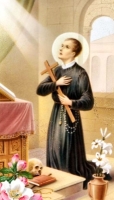
Son of a tailor who died when the boy was 12, leaving the family in poverty. Gerard tried to join the Capuchins, but his health prevented it He was accepted as a Redemptorist lay brother serving his congregation as sacristan, gardener, porter, infirmarian, and tailor. Miracle worker.
When falsely accused by a pregnant woman of being the father of her child, he retreated to silence; she later recanted and cleared him, and thus began his association as patron of all aspects of pregnancy. Reputed to bilocate and read consciences. His last will consisted of the following small note on the door of his cell: "Here the will of God is done, as God wills, and as long as God wills."
23 April 1725 at Muro, Italy
• 16 October 1755 at Caposele, Provincia di Avellino, Campania, Italy of tuberculosis
• interred in the Basilica di San Gerardo Maiella in Materdomini Caposele, Provincia di Avellino, Campania, Italy
11 December 1904 by Pope Saint Pius X
• childbirth
• children
• expectant mothers
• falsely accused people
• good confessions
• lay brothers
• motherhood
• mothers
• pregnant women
• pro-life movement
• unborn children
• Basilicata, Italy
• Muro, Italy
The Most Blessed Sacrament is Christ made visible. The poor sick person is Christ again made visible. - Saint Gerard Majella
I see in my neighbor the Person of Jesus Christ. - Saint Gerard Majella
Consider the shortness of time, the length of eternity and reflect how everything here below comes to an end and passes by. Of what use is it to lean upon that which cannot give support? - Saint Gerard Majella
Who except God can give you peace? Has the world ever been able to satisfy the heart? - Saint Gerard Majella
https://catholicsaints.info/saint-gerard-majella/
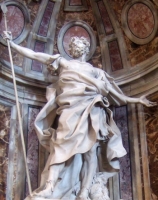
Longino
• 15 October (Extraordinary Form)
• 22 October (Armenian Apostolic Church)
Soldier who pierced the side of Jesus at the Crucifixion. Convert. Martyred by order of Pontius Pilate.
Cappadocia
• martyred in Cappadocia in the 1st century
• relics in the church of Saint Augustine, Rome, Italy
soldiers
• lance
• soldier, often in a uniform contemporaneous with the artist, carrying a spear
• soldier at the foot of the cross
When Jesus had taken the wine, he said, "It is finished." And bowing his head, he handed over the spirit. Now since it was preparation day, in order that the bodies might not remain on the cross on the sabbath, for the sabbath day of that week was a solemn one, the Jews asked Pilate that their legs be broken and they be taken down. So the soldiers came and broke the legs of the first and then of the other one who was crucified with Jesus. But when they came to Jesus and saw that he was already dead, they did not break his legs, but one soldier thrust his lance into his side, and immediately blood and water flowed out. An eyewitness has testified, and his testimony is true; he knows that he is speaking the truth, so that you also may (come to) believe. For this happened so that the scripture passage might be fulfilled: "Not a bone of it will be broken." And again another passage says: "They will look upon him whom they have pierced." - John 19:30-37
https://catholicsaints.info/saint-longinus-the-centurian/
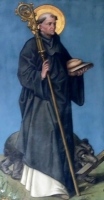
Callo, Chelleh, Gaaech, Gallen, Gallo, Gallonus, Gallunus, Gallus, Gilianus
Younger brother of Saint Deicola. Studied at Bangor Abbey under Saint Comgall of Bangor and Saint Columba. Bible scholar. Priest. One of the twelve who accompanied Saint Columbanus to France and helped found Luxeuil Abbey. He followed Columbanus into exile in 610 and then to Austrasia, where he preached with little success around Lake Zurich, and near Bregenz.
Illness forced Gall to leave Columbanus's party in 612, though some say the leader suspected Gall of malingering, and imposed a penance on him, which Gall faithfully observed, of not celebrating Mass during Columba's life. When he recovered, Gall lived as a hermit on the Steinach River, attracting disciples. Saint Gall Monastery occupied this site, becoming a center of literature, the arts, and music, though legend to the contrary, Saint Gall did not found it. Worked there with Saint Magnus of Füssen. Legend also says that one night during this period Gall ordered a bear to bring fire wood for his group of hermits - and it did.
Exorcist. Twice refused bishoprics offered by King Sigebert, whose betrothed he had freed of demons which fled from her in the form of blackbirds. Reportedly was the offered the abbacy of Luxeuil on the death of Saint Eustace but declined, and remained a hermit.
Irish
c.630 at Bregenz, Switzerland
• birds, geese, poultry
• Sweden
• Switzerland
• abbot blessing a bear, which brings him a log of wood
• birds
• carrying a loaf and a pilgrim's staff
• holding a hermit's tau staff with a nearby bear with a log
https://catholicsaints.info/saint-gall/

Son of a military officer. His family exepected a military life for Bertrand, but he was drawn to religion, joined the canons of Toulouse, and became an archdeacon. Bishop of Comminges, France c.1075, a position he served for nearly 50 years; this area is part of the modern diocese of Toulouse. Reformed the clergy, enforced their discipline, and placed the cathedral canons under Augustinian Rule. Worked in the Synod of Poitiers in 1100; this synod excommunicated King Philip I, and were stoned by the public for their trouble. Helped preside at the consecration of the cemetery of Saint Mary at Auch during which some embittered monks from Saint Orens tried to burn down the church.
Once during a sermon at Val d'Azun, Bertrand was particularly forceful in taking the faithful to task for their sins. A near riot broke out, which Bertrand calmed before serious problems occurred. To make up for the disturbance, the local leaders agreed to provide free butter to Comminges every year during the week after Pentecost, a custom that continued until stopped by the French Revolution nearly 700 years later.
11th century France
1123 of natural causes
1309 by Pope Alexander III
Saint-Bertrand-de-Comminges, France
https://catholicsaints.info/saint-bertrand-of-comminges/
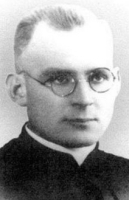
prisoner 16895
12 June as one of the 108 Martyrs of World War II
Second of eight children of Robert and Michalina Jankowski. Joined the Pallottines in 1929, making his final vows on 5 August 1931. Ordained on 2 August 1936 in the archdiocese of Gniezno, Poland. Particularly involved in ministry to children and young people, working as a chaplain and catechist in schools in the area of Oltarzew, Poland. Seminary treasurer and director of novices on 31 March 1941. Had a devotion to Saint Teresa of Avila who inspired his interior spiritual life. Tortured and martyred in the Nazi persecutions.
17 November 1910 in Czyczkowy, Kujawsko-Pomorskie, Poland
beaten to death by a guard on 16 October 1941 in the prison camp at Oswiecim (Auschwitz), Malopolskie, occupied Poland
13 June 1999 by Pope John Paul II in Warsaw, Poland
• Oltarzew, Poland
• Ozarów Mazowiecki, Poland
https://catholicsaints.info/blessed-jozef-jankowski/
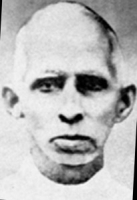
• Kunjachan
• Good Shepherd of the Dalits
Priest in the eparchy of Palai, India, ordained on 17 December 1921. Worked the the "untouchable" caste in India, bringing them to the faith, and giving them some basic education to improve their lot in this world.
1 April 1891 in Ramapuram, Kerala, India
16 October 1973 in Ramapuram, Kerala, India of natural causes
• 30 April 2006 by Pope Benedict XVI
• recognition celebrated at Ramapuram, Palai, India
https://catholicsaints.info/blessed-augustine-thevarparampil/
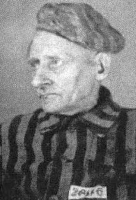
Adalbert Koplinski
12 June as one of the 108 Polish Martyrs of World War II
Franciscan Capuchin friar. Priest. Friend of Blessed Fidelis Chojnacki. Martyred in the Nazi persecutions of World War II.
30 July 1875 at Debrzyno, Pomorskie, Poland
16 October 1941 in the gas chambers of the Auschwitz concentration camp in occupied Poland
13 June 1999 by Pope John Paul II at Warsaw, Poland
https://catholicsaints.info/blessed-anicet-koplinski/
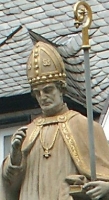
Lul, Lullon, Lullus, Lulo
Related to Saint Boniface. Monk at Malmesbury Abbey in England. Missionary to Germany with Boniface who ordained him a priest with a mission of training new priests. Bishop of Mainz, Germany. After the death of Boniface, Lull took charge of the missionary work. Founded several monasteries in the region.
787
https://catholicsaints.info/saint-lull/
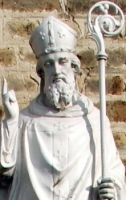
Momelin, Mommolenus, Mommolinus, Mummolin
Monk at Luxeuil Abbey in France. Abbot at the monastery at Saint Omer. Abbot of Sithin. Friend of Saint Bertin the Great. Bishop of Noyon-Tournai, Belgium.
at Constance, Scotland
c.686 of natural causes
https://catholicsaints.info/saint-mummolinus/

Eloff, Elophe, Éliphe
Martyred in the persecutions of Julian the Apostate.
in Ireland
• beheaded in 362 in Toul, France
• relics translated to Cologne, Germany in the 10th century
https://catholicsaints.info/saint-eliphius-of-toul/
Ambroise, Ambrosius
Bishop of Cahors, France during a turbulent period; he was forced to flee his diocese several times to escape enemies. He retired from his see to live as a hermit near Bourges, France. In his old age he made a pilgimage to Rome, Italy.
c.752 at Saint-Ambroise-sur-Arnon, Berry, France
https://catholicsaints.info/saint-ambrose-of-cahors/
Baldric, Baudry, Balderik, Balderich, Beaufroi
Born a prince, the son of King Sigebert I of Austrasia, an area in the east of modern France; brother of Saint Bova, and uncle of Saint Doda of Rheims. Founded the monastery of Montfaucon in Switzerland and a convent for his sister in Rheims, France.
c.640 of natural causes
https://catholicsaints.info/saint-balderic/
Monk on the island of Tombolenia of the coast of Brittany, France. Monk at the monastery of Cluny. Hermit in the region of the Pyrenees in western France.
Venice, Italy
c.1085 near Pamiers, Gaul (in modern France) of natural causes
https://catholicsaints.info/saint-anastasius-of-tombolenia/
Dominican priest. Martyred in the Spanish Civil War.
4 December 1877 in San Miguel de Dueñas, León, Spain
16 October 1936 in Madrid, Spain
28 October 2007 by Pope Benedict XVI
https://catholicsaints.info/blessed-jesus-villaverde-andres/
Cistercian monk at Fossanuova Abbey. Abbot of Fossanuova. Abbot of Clairvaux in 1170.
at Lombardy, Italy
killed by an unruly brother monk in 1177 at Igny Abbey, Arcis-le-Ponsart, Marne, France
https://catholicsaints.info/blessed-gerald-of-fossanuova/
Dulcet, Dulcidio, Doucis
Bishop of Agen, France. Fought the Arian heresy, brought to his diocese by invading Vandals and Visigoths. Miracle worker.
c.450 in Agen, Aquitaine (in modern France)
https://catholicsaints.info/saint-dulcidius-of-agen/
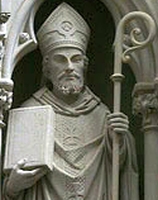
• Florentinus of Treve
• Florentius...
Fourth-century bishop of Trier, Germany.
https://catholicsaints.info/saint-florentinus-of-trier/
Salvan, Sauvan, Silvain, Souvain, Sylvanus
Deacon martyred by Vandals.
c.264 in Agedunum, Gaul (modern Ahun, France)
deacon in a dalmatic holding a book and palm
https://catholicsaints.info/saint-silvanus-of-ahun/
• Amandus of Haute-Vienne
• Amand, Amatius, Amantius
Hermit at the conflux of the Glanne and Vienne Rivers, diocese of Limoges, France.
5th century of natural causes
https://catholicsaints.info/saint-amandus-of-limoges/
Balduin, Balduinus, Baudoin, Baudouin, Boudewijn
Son of Saint Sadalberga and Saint Blandinus of Laon. Brother of Saint Anstrude of Laon. Archdeacon of Laon in the time of Dagobert I, King of France. Martyred by Ebroin.
c.680
https://catholicsaints.info/saint-baldwin/

Albinus, Conogon, Gwen
Bishop of Quimper, France.
460
https://catholicsaints.info/saint-conogan-of-quimper/
Vial
Monk on Noirmoutier-en-l'Île, France. Hermit on Mont Scobrit near the Loire River.
in England
c.740
https://catholicsaints.info/saint-vitalis-of-noirmoutier/
Mainboeuf, Maimbod
Born to the Frankish nobility. Bishop of Angers, France, chosen by popular acclaim due to his personal piety.
c.670
https://catholicsaints.info/saint-magnobodus-of-angers/
Enslaved by Arian Vandals in Mauretania in North Africa. Martyred in the persecutions of Genseric.
dragged to death by horses in 458
https://catholicsaints.info/saint-martinian-of-mauretania/
Enslaved by Arian Vandals in Mauretania in North Africa. Martyred in the persecutions of Genseric.
dragged to death by horses in 458
https://catholicsaints.info/saint-saturian-of-mauretania/
Boulogne
Nun. Martyred at age 15 in the persecutions of Julian the Apostate. Then village of Saint Boulogne in Maine, France is named for her.
362
https://catholicsaints.info/saint-bolonia/
Gauderico
Farmer in the region of the Pyrenees known for his devotion to the Mother of God.
https://catholicsaints.info/saint-gaudericus-of-mirepoix/
Niece of Saint Wulmar. Seventh-century nun. Abbess of Wierre-aux-Bois Abbey in France which Wulmar built for her.
https://catholicsaints.info/saint-eremberta-of-wierre/
Tenth-century nun in the region of Brioude, Aquitaine (in modern France).
https://catholicsaints.info/saint-bonita-of-brioude/
Eighth-century hermit in the region of Retz, Brittany (near modern Nantes, France).
https://catholicsaints.info/saint-vidal-of-retz/
Fifth-century hermit at Commodoliacus (modern Saint-Junien, France). Known as a miracle worker.
https://catholicsaints.info/saint-junian/
A group of 220 Christians martyrs about whom we know nothing but that they died for their faith.
https://catholicsaints.info/martyrs-in-africa-16-october/
A group of 365 Christians who were martyred together in the persecutions of the Vandal king Genseric. The only details that have survived are the names of two of the martyrs - Nereus and Saturninus.
450 in North Africa
https://catholicsaints.info/martyrs-of-north-africa/
• Purity of the Blessed Virgin Mary
• Evodius of Uzala
• Fortunatus of Casei
• Petra de San José
CatholicSaints.Info Portable Edition